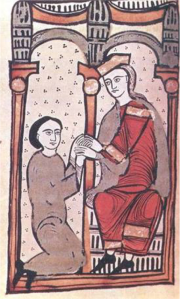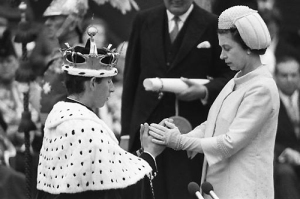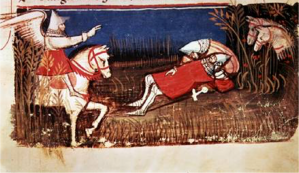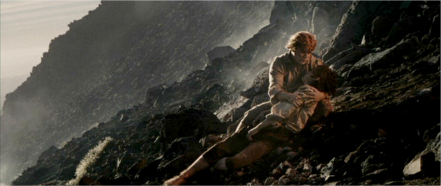As I indicated in a previous entry, I wanted to post some of the images that I used when delivering my Tolkien 2005 conference paper. That paper (without the images) is included in the proceedings now on sale by the Tolkien Society.
Back in 2005, my presentation, “Male Friendship in The Lord of the Rings: Medievalism, The First World War, and Contemporary Rewritings,” discussed the Frodo and Sam relationship in both medieval and modern contexts. I wanted to show that a tradition of male friendship, especially in war, stretches far back in time.
For example, just as Roland has his Oliver in the Song of Roland (here pictured in a 14th-century manuscript):
and Beowulf has his Wiglaf (by J.H.F. Bacon, c. 1910):
so too, Frodo has his Sam:
While I wanted to show how a tradition of male friendship can be traced back to the early medieval period (and I could have gone beyond that, of course, but I only had 20 minutes for my talk!), I also tried to place the Frodo-Sam relationship in a modern and contemporary context. I looked at the nature of World War One friendships, then at how Peter Jackson had portrayed Frodo and Sam in his films, and finally at how subsequent fanfic writers have generally represented the two.
But as I was thinking about the medievalized elements in Frodo and Sam’s friendship, I was struck by one moment in Return of the King when the two of them are near the end of their climb up Mount Doom. Consider this passage:
‘Help me, Sam! Help me, Sam! Hold my hand! I can’t stop it.’ Sam took his master’s hands and laid them together, palm to palm, and kissed them; and then he held them gently between his own.
At this point, Frodo and Sam are very close to the end of their climb. As the Eye moves to gaze at the Captains of the West, Frodo falls to the ground as if he’s “stricken mortally.” Sam is kneeling beside him. Of course, it’s completely natural for Frodo to ask Sam to hold his hand to keep it from reaching for the Ring around his neck. And it’s quite in keeping with Sam’s previous attempts to comfort his Master by holding his hands, as he does several times before this in various situations.
But the specific actions that are described here are also reminiscent of the medieval ceremony in which a vassal pays homage to a lord. Typically, the vassal places himself in a lower position than his lord by kneeling before him. He offers his hands in a prayer gesture, palm to palm, to his lord, who places his own hands over them as a sign that he will offer protection to his vassal.

On Mount Doom, Frodo is in the lower position on the ground and Sam is kneeling above him. Frodo offers his hands as a vassal would do, and Sam takes them between his own, as if he were the superior in the relationship. I find this reversal very telling. Sam has always directed his loyalty to his “Master,” acting as his servant. Now, Frodo is acknowledging Sam’s leadership role by putting himself into Sam’s hands, both literally and symbolically. He is becoming Sam’s man, as if he were a vassal pledging himself to a lord.
This reversal only acknowledges what has already happened in the story by this point. Sam has increasingly taken the lead in their journey and made decisions for both of them in his effort to protect Frodo.
The ceremony of homage between vassal and lord existed in many European countries and over centuries in the medieval period, so it should not be surprising that variations occurred. In my 2005 article, I interpreted the scene in the light of one of these versions, in which a vassal kisses his lord’s hands in the ceremony. Because it’s Sam who kisses the clasped pair of hands, I had read that as a sign of “a reciprocal exchange in which Frodo acknowledges the need for Sam’s leadership and protection, and Sam acknowledges his willingness to be both vassal and lord” (324). Since writing this, though, I’ve read that in some instances the lord did kiss the vassal’s hands and in others, the kiss did not occur until an oath of fealty was sworn after the homage ritual. In any case, some historians do point out that the ceremony of vassalage created a reciprocal relationship between the two parties, with equal demands on both sides.

However we interpret the details, I can’t help but see the basic homage ritual (hands clasped together and enfolded in another person’s hands) as reflected in this moment between Frodo and Sam. In that light, the scene looks forward to the time when Sam will become the Master of Bag End; in fact, to me it makes that conclusion seem inevitable.
Bibliography
The original article in the 2005 proceedings did not have a bibliography attached. For the sake of completion, you can look at the Works Cited list here [pdf].
Images:
Roland and Oliver. Illustration from the Song of Roland. 14th century. Wikimedia Commons Image; https://commons.wikimedia.org/wiki/File%3ARoland_Kleine.jpg
Frodo and Sam. Peter Jackson, Return of the King. Image from The Lord of the Rings Image Library.
From a 12th-century manuscript, Liber Feudorum Major. Wikimedia Commons Image: https://en.wikipedia.org/wiki/Ermengol_II,_Count_of_Urgell#/media/File:LiberErmengol_Arnau.jpg
Prince Charles and Queen Elizabeth 1969 investiture ceremony. https://www.royal.gov.uk/ImagesandBroadcasts/Galleries/Royalresidences/TheQueeninWales.aspx



One response to “Tolkien’s nod to the medieval homage ritual in LotR”
[…] sworn friendship, helps to explain events once they return home. I’ve described that pledge in a previous post. Suffice it to say that it involves another scene of tender hand-holding on Mount Doom in which […]
LikeLike